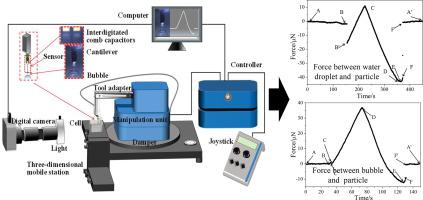当前位置:
X-MOL 学术
›
Powder Technol.
›
论文详情
Our official English website, www.x-mol.net, welcomes your feedback! (Note: you will need to create a separate account there.)
New method to measure interaction force between particle and air bubble/water droplet using a micro-Newton mechanics testing instrument
Powder Technology ( IF 5.2 ) Pub Date : 2020-08-01 , DOI: 10.1016/j.powtec.2020.06.049 Youfei Zhang , Yaowen Xing , Shihao Ding , Yijun Cao , Xiahui Gui
Powder Technology ( IF 5.2 ) Pub Date : 2020-08-01 , DOI: 10.1016/j.powtec.2020.06.049 Youfei Zhang , Yaowen Xing , Shihao Ding , Yijun Cao , Xiahui Gui

|
Abstract The interaction force between particle and air bubble/water droplet is the key to understand the underlying mechanism for mineral flotation. The most commonly used approach is colloidal probe atomic force microscopy (AFM), which usually operates in the nano-Newton range. This makes the quantification of the adhesion (capillary) force during retraction challenging, because the magnitude of the adhesion force is much higher than that of surface forces. In this short communication, a new instrument, the micro-mechanical testing machine (MMTM), was used to measure the interaction force between a micrometer glass bead and an air bubble/water droplet with both micro-Newton range and nano-Newton resolution. A single-axis capacitive microforce sensor based on interdigitated comb capacitors was equipped in the MMTM. Similar to the colloidal probe AFM, a hydrophilic glass bead with a diameter of 193 μm was adhered to the end of the cantilever. The MMTM allows the simultaneous recording of the data of force, displacement, and time at a fixed velocity. The results showed that a strong jump-into contact and adhesion force were observed between the particle and water droplet. In contrast, a weaker jump-into and smaller adhesion force were observed between the bubble and particle. Based on the theoretical equation of the adhesion force, the equilibrium contact angle of the glass bead used was back calculated to be approximately 39.58°, which is reasonable for its force behavior. The MMTM provides a flexible and alternative way to investigate the surface and interfacial forces in flotation systems.
中文翻译:

使用微牛顿力学测试仪测量粒子与气泡/水滴相互作用力的新方法
摘要 颗粒与气泡/水滴之间的相互作用力是理解矿物浮选机理的关键。最常用的方法是胶体探针原子力显微镜 (AFM),它通常在纳米牛顿范围内运行。这使得在收缩过程中对粘附(毛细管)力的量化具有挑战性,因为粘附力的大小远高于表面力的大小。在这次简短的交流中,一种新仪器——微机械试验机(MMTM)被用来测量微米玻璃珠与气泡/水滴之间的相互作用力,具有微牛顿范围和纳牛顿分辨率。MMTM 中配备了基于叉指梳状电容器的单轴电容微力传感器。与胶体探针 AFM 类似,直径为 193 μm 的亲水玻璃珠粘附在悬臂的末端。MMTM 允许以固定速度同时记录力、位移和时间的数据。结果表明,在颗粒和水滴之间观察到强烈的跳跃接触和粘附力。相比之下,在气泡和颗粒之间观察到较弱的跳入和较小的粘附力。根据粘附力的理论方程,所用玻璃珠的平衡接触角反算约为 39.58°,这对于其受力行为是合理的。MMTM 提供了一种灵活的替代方法来研究浮选系统中的表面和界面力。直径为 193 μm 的亲水玻璃珠粘附在悬臂的末端。MMTM 允许以固定速度同时记录力、位移和时间的数据。结果表明,在颗粒和水滴之间观察到强烈的跳跃接触和粘附力。相比之下,在气泡和颗粒之间观察到较弱的跳入和较小的粘附力。根据粘附力的理论方程,所用玻璃珠的平衡接触角反算约为 39.58°,这对于其受力行为是合理的。MMTM 提供了一种灵活的替代方法来研究浮选系统中的表面和界面力。直径为 193 μm 的亲水玻璃珠粘附在悬臂的末端。MMTM 允许以固定速度同时记录力、位移和时间的数据。结果表明,在颗粒和水滴之间观察到强烈的跳跃接触和粘附力。相比之下,在气泡和颗粒之间观察到较弱的跳入和较小的粘附力。根据粘附力的理论方程,所用玻璃珠的平衡接触角反算约为 39.58°,这对于其受力行为是合理的。MMTM 提供了一种灵活的替代方法来研究浮选系统中的表面和界面力。位移和时间在一个固定的速度。结果表明,在颗粒和水滴之间观察到强烈的跳跃接触和粘附力。相比之下,在气泡和颗粒之间观察到较弱的跳入和较小的粘附力。根据粘附力的理论方程,所用玻璃珠的平衡接触角反算约为 39.58°,这对于其受力行为是合理的。MMTM 提供了一种灵活的替代方法来研究浮选系统中的表面和界面力。位移和时间在一个固定的速度。结果表明,在颗粒和水滴之间观察到强烈的跳跃接触和粘附力。相比之下,在气泡和颗粒之间观察到较弱的跳入和较小的粘附力。根据粘附力的理论方程,所用玻璃珠的平衡接触角反算约为 39.58°,这对于其受力行为是合理的。MMTM 提供了一种灵活的替代方法来研究浮选系统中的表面和界面力。根据粘附力的理论方程,所用玻璃珠的平衡接触角反算约为 39.58°,这对于其受力行为是合理的。MMTM 提供了一种灵活的替代方法来研究浮选系统中的表面和界面力。根据粘附力的理论方程,所用玻璃珠的平衡接触角反算约为 39.58°,这对于其受力行为是合理的。MMTM 提供了一种灵活的替代方法来研究浮选系统中的表面和界面力。
更新日期:2020-08-01
中文翻译:

使用微牛顿力学测试仪测量粒子与气泡/水滴相互作用力的新方法
摘要 颗粒与气泡/水滴之间的相互作用力是理解矿物浮选机理的关键。最常用的方法是胶体探针原子力显微镜 (AFM),它通常在纳米牛顿范围内运行。这使得在收缩过程中对粘附(毛细管)力的量化具有挑战性,因为粘附力的大小远高于表面力的大小。在这次简短的交流中,一种新仪器——微机械试验机(MMTM)被用来测量微米玻璃珠与气泡/水滴之间的相互作用力,具有微牛顿范围和纳牛顿分辨率。MMTM 中配备了基于叉指梳状电容器的单轴电容微力传感器。与胶体探针 AFM 类似,直径为 193 μm 的亲水玻璃珠粘附在悬臂的末端。MMTM 允许以固定速度同时记录力、位移和时间的数据。结果表明,在颗粒和水滴之间观察到强烈的跳跃接触和粘附力。相比之下,在气泡和颗粒之间观察到较弱的跳入和较小的粘附力。根据粘附力的理论方程,所用玻璃珠的平衡接触角反算约为 39.58°,这对于其受力行为是合理的。MMTM 提供了一种灵活的替代方法来研究浮选系统中的表面和界面力。直径为 193 μm 的亲水玻璃珠粘附在悬臂的末端。MMTM 允许以固定速度同时记录力、位移和时间的数据。结果表明,在颗粒和水滴之间观察到强烈的跳跃接触和粘附力。相比之下,在气泡和颗粒之间观察到较弱的跳入和较小的粘附力。根据粘附力的理论方程,所用玻璃珠的平衡接触角反算约为 39.58°,这对于其受力行为是合理的。MMTM 提供了一种灵活的替代方法来研究浮选系统中的表面和界面力。直径为 193 μm 的亲水玻璃珠粘附在悬臂的末端。MMTM 允许以固定速度同时记录力、位移和时间的数据。结果表明,在颗粒和水滴之间观察到强烈的跳跃接触和粘附力。相比之下,在气泡和颗粒之间观察到较弱的跳入和较小的粘附力。根据粘附力的理论方程,所用玻璃珠的平衡接触角反算约为 39.58°,这对于其受力行为是合理的。MMTM 提供了一种灵活的替代方法来研究浮选系统中的表面和界面力。位移和时间在一个固定的速度。结果表明,在颗粒和水滴之间观察到强烈的跳跃接触和粘附力。相比之下,在气泡和颗粒之间观察到较弱的跳入和较小的粘附力。根据粘附力的理论方程,所用玻璃珠的平衡接触角反算约为 39.58°,这对于其受力行为是合理的。MMTM 提供了一种灵活的替代方法来研究浮选系统中的表面和界面力。位移和时间在一个固定的速度。结果表明,在颗粒和水滴之间观察到强烈的跳跃接触和粘附力。相比之下,在气泡和颗粒之间观察到较弱的跳入和较小的粘附力。根据粘附力的理论方程,所用玻璃珠的平衡接触角反算约为 39.58°,这对于其受力行为是合理的。MMTM 提供了一种灵活的替代方法来研究浮选系统中的表面和界面力。根据粘附力的理论方程,所用玻璃珠的平衡接触角反算约为 39.58°,这对于其受力行为是合理的。MMTM 提供了一种灵活的替代方法来研究浮选系统中的表面和界面力。根据粘附力的理论方程,所用玻璃珠的平衡接触角反算约为 39.58°,这对于其受力行为是合理的。MMTM 提供了一种灵活的替代方法来研究浮选系统中的表面和界面力。


























 京公网安备 11010802027423号
京公网安备 11010802027423号